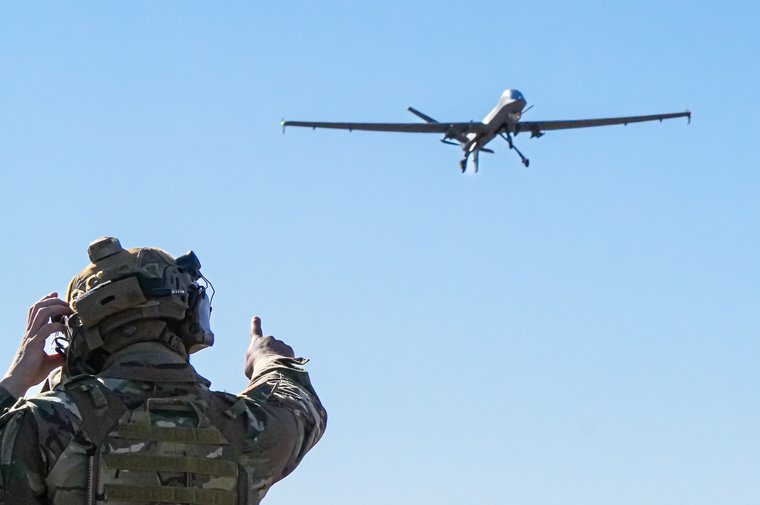Shaping the future of defence: What 2025 holds for the global drone market
Details
More Products & Services
Products & Services
Military Unmanned Systems Handbook
Shephard Media
The Military Unmanned Systems Handbook (Digital Download) is an international guide to the military UV industry and provides detailed information on air, ground and sea (surface & sub-sea) vehicles as well as subsystems. What's included: Unencrypted 390+ page PDF of equipment and supplier information Market summary
Defence Insight
Shephard Media
Some of the things people like you use Defence Insight for:
- Total addressable market sizing ($)
- Competitor analysis
- Cost analysis
- Market forecasting
- Growth identification
- Increasing closing ratio
- Increasing closing order value
- Estimating product potential
- Calculating sales forecasting
- Supply and demand analysis
- Total addressable market sizing ($)
- Competitor analysis
- Cost analysis
- Market forecasting
- Growth identification
- Increasing closing ratio
- Increasing closing order value
- Estimating product potential
- Calculating sales forecasting
- Supply and demand analysis
Shephard Plus Update
Shephard Media
Shephard Plus is updating in June 2018 with rich new capabilities, and is now one of the most cost-effective and valuable aerospace and defence market intell...
Description
Drones are increasingly fulfilling roles traditionally reserved for crewed aircraft. Efforts like the US Air Force's Collaborative Combat Aircraft (CCA) programme demonstrate how UAVs can act as “loyal wingmen”, augmenting fighter formations and providing immediate ISR (intelligence, surveillance and reconnaissance) capabilities.
Additionally, rudimentary loitering munitions - often simply small rotary-wing drones fitted with explosive charges - are reshaping infantry tactics.
The evolution of drones has also impacted rotor-wing operations. Projects such as the US Navy's Blue Water Maritime Logistics UAS initiative aim to replace helicopters with drones for tasks like ship-to-ship cargo transfer, offering cost and personnel efficiency.
Related Articles
Poland “pushing hard” to bring loyal wingman for F-35 fleet
US Air Force aiming to have CCA operational by end of the decade
British Army and UK Royal Navy new counter-drone soft-kill systems near fielding
The Ukraine conflict has profoundly influenced the global drone market. NATO allies have responded by increasing drone procurement, funnelling more than£1 billion (US$1.2 billion)into ISR platforms and loitering munitions for Ukraine through international coalitions.
This urgency has accelerated European nations' drone programmes, as seen in Poland's planned rapid procurement of the MQ-9A Reaper, which later materialised into a lease of the system as a bridging solution before the MQ-9B was acquired in December 2024.
Ukraine itself has demonstrated innovative uses of drones, repurposing civilian and commercial rotary-wing platforms as low-cost ISR tools or improvised loitering munitions. This trend underscores the overlap between civilian and military drone capabilities, reinforcing the demand for scalable, dual-use platforms.Global UAV spending
Spending on UAVs in 2025 has been estimated to reach $8.2 billion, with the US leading investments at $1.9 billion (23.8% of global spending). Notably, $350 million has been earmarked for the Replicator 1 initiative, which aims to deploy thousands of attritable, autonomous systems across multiple domains before year-end.
India will bethe third-highest spender, dedicating $534 million (6.5% of global expenditure). Nearly half of this outlay willsupport its tri-service acquisition of 31 MQ-9B aircraft from General Atomics, announced in October 2024.
The UAE and the Netherlands will also be prominent contributors, projected to spend $418 million and $401 million, respectively, on MQ-9 platforms. The Netherlands, for instance, will invest $301 million to acquire four additional Block 5 MQ-9A Reapers, approved in 2023. Meanwhile, the UAE's procurement of 18 MQ-9B SkyGuardian UAVs, paused under the Biden administration, may resume under the incoming Trump administration.The shift to low-cost, disposable platforms
The emphasis on low-cost, mass-produced drones reflects a significant shift in strategy. The US Department of Defense's Replicator initiative exemplifies this approach, aiming to field thousands of inexpensive, attritable drones to counter China's growing UAV fleet. From $300 FPV drones to multi-million-dollar loyal wingmen, affordability and scalability are key priorities.
Ukraine's innovative use of drones as expendable assets has helped accelerate this move towards disposable platforms. Military planners recognise that this shift is critical for maintaining operational flexibility in high-intensity conflicts.The autonomous vehicle dubbed Blue Water Maritime Logistics UAS flies over Unmanned Air Test and Evaluation (UX) 24 during a demonstration flight at Naval Air Station Patuxent River in 2020. (Photo: US Navy)
The maritime domain is also witnessing notable advancements, with drones filling gaps in naval logistics and reconnaissance. The US Navy's focus on drone-based ship-to-shore operations highlights the growing role of UAS platforms in reducing logistical costs and improving efficiency. Meanwhile, India's procurement of MQ-9B SeaGuardian drones demonstrates how nations are leveraging UAVs for maritime ISR and strike missions.Looking ahead
The coming year promises further growth as NATO nations refine requirements for autonomous systems and explore multinational development programs.
European loyal wingman initiatives are expected to mature, building on prototypes revealed in 2024. The acceleration of the CCA project, with production-representative aircraft set for testing by 2025, will also set benchmarks for future UAV development.
The global drone market is not just evolving - it is redefining modern warfare. With technological innovation and strategic necessity driving demand, drones are poised to dominate battlefield and logistical operations in the years ahead.
Matty Todhunter is the Senior UAV Analyst at Shephard Defence Insight, focusing on uncrewed aerial systems, autonomy and UAV applications across defence sectors.
Related Programmes in Defence Insight
Replicator 1 [US]
Collaborative Combat Aircraft (CCA) [USN]
Blue Water Maritime Logistics UAS (BWUAS) [USA]
Related Equipment in Defence Insight
MQ-9B SkyGuardian / SeaGuardian
MQ-9A Reaper
Additionally, rudimentary loitering munitions - often simply small rotary-wing drones fitted with explosive charges - are reshaping infantry tactics.
The evolution of drones has also impacted rotor-wing operations. Projects such as the US Navy's Blue Water Maritime Logistics UAS initiative aim to replace helicopters with drones for tasks like ship-to-ship cargo transfer, offering cost and personnel efficiency.
Related Articles
Poland “pushing hard” to bring loyal wingman for F-35 fleet
US Air Force aiming to have CCA operational by end of the decade
British Army and UK Royal Navy new counter-drone soft-kill systems near fielding
The Ukraine conflict has profoundly influenced the global drone market. NATO allies have responded by increasing drone procurement, funnelling more than£1 billion (US$1.2 billion)into ISR platforms and loitering munitions for Ukraine through international coalitions.
This urgency has accelerated European nations' drone programmes, as seen in Poland's planned rapid procurement of the MQ-9A Reaper, which later materialised into a lease of the system as a bridging solution before the MQ-9B was acquired in December 2024.
Ukraine itself has demonstrated innovative uses of drones, repurposing civilian and commercial rotary-wing platforms as low-cost ISR tools or improvised loitering munitions. This trend underscores the overlap between civilian and military drone capabilities, reinforcing the demand for scalable, dual-use platforms.Global UAV spending
Spending on UAVs in 2025 has been estimated to reach $8.2 billion, with the US leading investments at $1.9 billion (23.8% of global spending). Notably, $350 million has been earmarked for the Replicator 1 initiative, which aims to deploy thousands of attritable, autonomous systems across multiple domains before year-end.
India will bethe third-highest spender, dedicating $534 million (6.5% of global expenditure). Nearly half of this outlay willsupport its tri-service acquisition of 31 MQ-9B aircraft from General Atomics, announced in October 2024.
The UAE and the Netherlands will also be prominent contributors, projected to spend $418 million and $401 million, respectively, on MQ-9 platforms. The Netherlands, for instance, will invest $301 million to acquire four additional Block 5 MQ-9A Reapers, approved in 2023. Meanwhile, the UAE's procurement of 18 MQ-9B SkyGuardian UAVs, paused under the Biden administration, may resume under the incoming Trump administration.The shift to low-cost, disposable platforms
The emphasis on low-cost, mass-produced drones reflects a significant shift in strategy. The US Department of Defense's Replicator initiative exemplifies this approach, aiming to field thousands of inexpensive, attritable drones to counter China's growing UAV fleet. From $300 FPV drones to multi-million-dollar loyal wingmen, affordability and scalability are key priorities.
Ukraine's innovative use of drones as expendable assets has helped accelerate this move towards disposable platforms. Military planners recognise that this shift is critical for maintaining operational flexibility in high-intensity conflicts.The autonomous vehicle dubbed Blue Water Maritime Logistics UAS flies over Unmanned Air Test and Evaluation (UX) 24 during a demonstration flight at Naval Air Station Patuxent River in 2020. (Photo: US Navy)
The maritime domain is also witnessing notable advancements, with drones filling gaps in naval logistics and reconnaissance. The US Navy's focus on drone-based ship-to-shore operations highlights the growing role of UAS platforms in reducing logistical costs and improving efficiency. Meanwhile, India's procurement of MQ-9B SeaGuardian drones demonstrates how nations are leveraging UAVs for maritime ISR and strike missions.Looking ahead
The coming year promises further growth as NATO nations refine requirements for autonomous systems and explore multinational development programs.
European loyal wingman initiatives are expected to mature, building on prototypes revealed in 2024. The acceleration of the CCA project, with production-representative aircraft set for testing by 2025, will also set benchmarks for future UAV development.
The global drone market is not just evolving - it is redefining modern warfare. With technological innovation and strategic necessity driving demand, drones are poised to dominate battlefield and logistical operations in the years ahead.
Matty Todhunter is the Senior UAV Analyst at Shephard Defence Insight, focusing on uncrewed aerial systems, autonomy and UAV applications across defence sectors.
Related Programmes in Defence Insight
Replicator 1 [US]
Collaborative Combat Aircraft (CCA) [USN]
Blue Water Maritime Logistics UAS (BWUAS) [USA]
Related Equipment in Defence Insight
MQ-9B SkyGuardian / SeaGuardian
MQ-9A Reaper

Share
Recent Chats
Share via email
Future: handle WhatsApp here
Future: handle LinkedIn here
Future: handle Twitter here
SUBMENU HERE
Share via Chat
Copy Link



